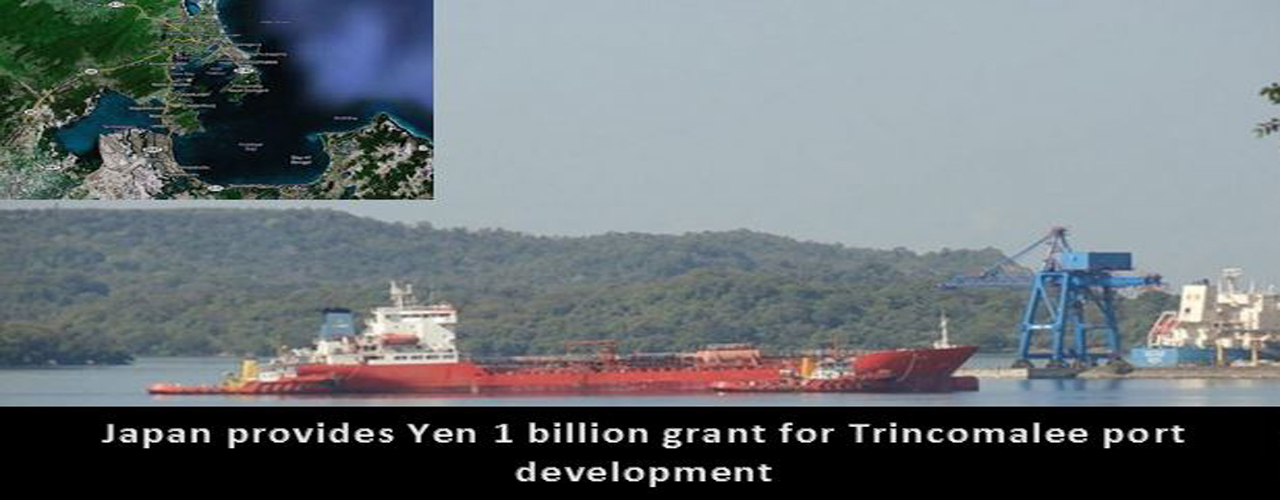Japan provides Yen 1 billion grant for Trincomalee port development
The government of Japan has agreed to provide 1 billion Yen (approximately Rs. 1.3) Billion as a non-project grant to the development of the Trincomalee port. The prime minister had proposed to sign exchange notes with the government of Japan to obtain the grant and the cabinet had approved the proposal.
Japan is one of Sri Lanka’s biggest grand aid providers and the grant for developing Trincomalee port comes with another two massive grants being granted to a total amount of 45 Billion Japanese Yen (Rs. 63 Billion). The exchange of notes was carried out following the Japan – Sri Lanka Summit meeting in Tokyo between Ambassador of Japan to Sri Lanka and Ambassador of Sri Lanka to Japan. Prof. Dammika Ganganath Dissanyake. The signing of exchange of notes was carried out with the participation of both the Japanese Prime Minister Shinzo Abe and Sri Lankan Prime Minister Ranil Wickramsinge. Of the three two have been Yen Loan Projects and one grant aid (Trincomalee Grant). Of the Allocation 12.957 billion yen has been allocated to the “Rural Infrastructure Development Project in Emerging Regions” and the amount of remaining 31.81 has been allocated to “Kalu ganga Water Supply Expansion project” Two loans are set at an interest rate of 1.4% per annum and 0.01% per annum for consulting services and for a 25 year period with a seven year grace period.
The grant for the Trincomalee Harbor is to be used to develop the maritime guidance system at the port and to increase the volume of activities in the harbor. However, a condition of the grant is that the funds be used to obtain required Japanese Products needed for such activities. It is expected this will contribute massively to the ongoing efforts to restore the conflicted affected surroundings.
The Trincomalee Harbor which operates 24 hours a day and 364 days a year barring May 1st and with only daylight navigation had been identified by the Sri Lanka ports authority as having the potential to be developed as a location to cater for bulk and break bulk cargo as well as various industrial activities. Few such as tourism and Agriculture has been at the forefront of this approach along with heavy industries. According the Sri Lanka ports authority it is the second best Natural Harbor in the world and has up to 10 times the land area as of Colombo Port and is currently in the process of being developed as a metropolis growth center. Its current dimensions are Water area up to – 1630 Hectares, an entrance channel of 500 Meters and a land area of 5261 hectares.
Experts see this grant as the latest in a series of strategic maneuvers by Japan to secure a free and open Indian ocean and as an effort to counter growing Chinese presence in the island nation of Sri Lanka. A joint statement issued by both Sri Lankan and Japanese prime minister read that in principle Indo-pacific oceans needed to be “free and open”. Japanese premier Shinzo Abe was quoted saying “True regional prosperity could not come to being without the realization of a free and open Indo-pacific”. Furthermore, adding that “To make this happen it is indispensable for Sri Lanka to achieve Sustainable growth as a hub and develop ports that are open to all”, and that Japan would continue to aid Sri Lanka in developing quality infrastructure. This move has been described as Japanese media as closer ties with could help Japan secure sea lanes to import oil from middle east which is of paramount importance.
However, Trincomalee Harbor has generated some controversy due to the issues surrounding the oil tanks which are based on China Bay and have been leased to an Indian Company. Ceylon Petroleum workers has been launching a few protests on this.
The controversy has been of particular strain to relationship between Sri Lanka and India as Sri Lanka expects to develop the Trincomalee Harbor with the join participation of its Indian counterparts. Diplomatic sources have confirmed that a MoU has already in the final stages and with the signing expected in the upcoming visit by Indian Prime Minister Modi’s to Sri Lanka in the month of May.
As the onus of Sri Lankan port development had been firmly placed in Hambantota for a long duration and on Colombo the potential for Trincomalee Port with its outer and Inner Ports as well massive land and water areas are ripe for development. Trincomalee port is the only port in the region which can be used by any type of vessel under any weather condition and it places a prime value on the port. Also, it is becoming evident by the level of interest generated by states such as both India and Japan they are also recognizing the value of the Trincomalee port. It could very well be the next big naval and maritime venture both in the region and in Sri Lanka.
| Article Code : | VBS/AT/25042017/Z-1 |

